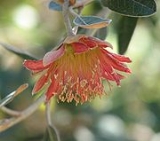
Diplolaena grandiflora
Encyclopedia
Diplolaena grandiflora, commonly known as Wild Rose or Tamala Rose, is a shrub
Shrub
A shrub or bush is distinguished from a tree by its multiple stems and shorter height, usually under 5–6 m tall. A large number of plants may become either shrubs or trees, depending on the growing conditions they experience...
which is endemic to Western Australia
Western Australia
Western Australia is a state of Australia, occupying the entire western third of the Australian continent. It is bounded by the Indian Ocean to the north and west, the Great Australian Bight and Indian Ocean to the south, the Northern Territory to the north-east and South Australia to the south-east...
.
Description
Diplolaena grandiflora grows to between 0.5 and 3 metres high and has an erect habit. In a period between late autumn and spring, it produces showy, upright or pendant flowers . These have a cluster of red stamens in the centre, surrounded by pinkish-red bracts. The leaves are ovate and are up to 5 cm in length and are dark green on the top and downy on the undersides.Distribution
Diplolaena grandiflora occurs on limestoneLimestone
Limestone is a sedimentary rock composed largely of the minerals calcite and aragonite, which are different crystal forms of calcium carbonate . Many limestones are composed from skeletal fragments of marine organisms such as coral or foraminifera....
outcrops and ridges in an area between Geraldton
Geraldton, Western Australia
Geraldton is a city and port in Western Australia located north of Perth in the Mid West region. Geraldton has an estimated population at June 2010 of 36,958...
and North West Cape
North West Cape
North West Cape is a large peninsula of land in the north west coast of Western Australia. Cape Range runs down the spine of the peninsula and Ningaloo Reef runs along the western edge...
.
Taxonomy
Despite its common name of "Wild Rose", it is not closely related to the roseRose
A rose is a woody perennial of the genus Rosa, within the family Rosaceae. There are over 100 species. They form a group of erect shrubs, and climbing or trailing plants, with stems that are often armed with sharp prickles. Flowers are large and showy, in colours ranging from white through yellows...
, but rather it is placed in the family Rutaceae
Rutaceae
Rutaceae, commonly known as the rue or citrus family, is a family of flowering plants, usually placed in the order Sapindales.Species of the family generally have flowers that divide into four or five parts, usually with strong scents...
.
The first known scientific collection of the species was by William Dampier
William Dampier
William Dampier was an English buccaneer, sea captain, author and scientific observer...
during a voyage to New Holland
New Holland (Australia)
New Holland is a historic name for the island continent of Australia. The name was first applied to Australia in 1644 by the Dutch seafarer Abel Tasman as Nova Hollandia, naming it after the Dutch province of Holland, and remained in use for 180 years....
in 1699. The type specimen was collected in 1801 from Dirk Hartog Island
Dirk Hartog Island
Dirk Hartog Island is an island off the Gascoyne coast of Western Australia, within the Shark Bay World Heritage Area. It is about 80 kilometres long and between 3 and 15 kilometres wide and is Western Australia's largest and most western island. It covers an area of 620 square kilometres and is...
during a French voyage of exploration captained by Jacques Hamelin and Nicholas Baudin. The specimen was brought back to France and described by René Desfontaines
René Louiche Desfontaines
René Louiche Desfontaines was a French botanist.Desfontaines was born near Tremblay in Brittany. He attended the Collège de Rennes and in 1773 went to Paris to study medicine. His interest in botany originated from lectures at the Jardin des Plantes given by Louis Guillaume Lemonnier...
in 1817, who gave it the specific epithet of grandiflora meaning "large-flowered".

